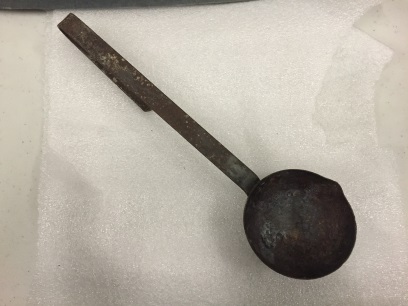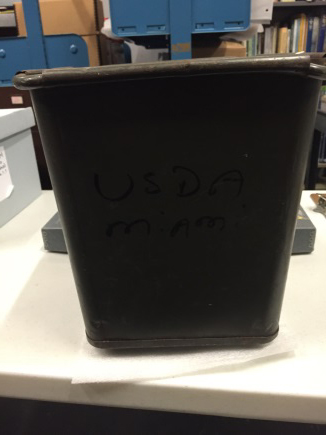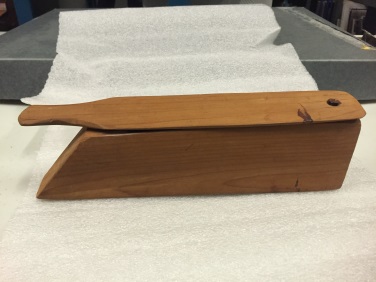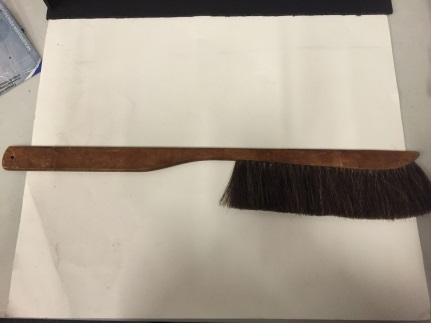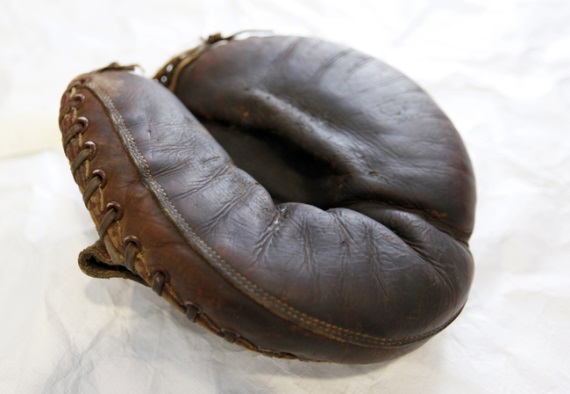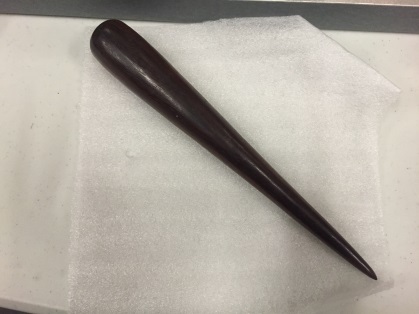Each month we have a special event for our members. Last month was Fact or Fiction, where we provided two stories for each object brought from the collections storage. It was up to the members to decide which story was the correct one.
Many of these objects might not see the inside of an exhibit space and to have the opportunity to highlight them is fun for us. We thought that since not everyone could be at the event we would share the facts with all of you.
Enjoy this in-depth look at some of the artifacts that caught our interest!
Hygrometer
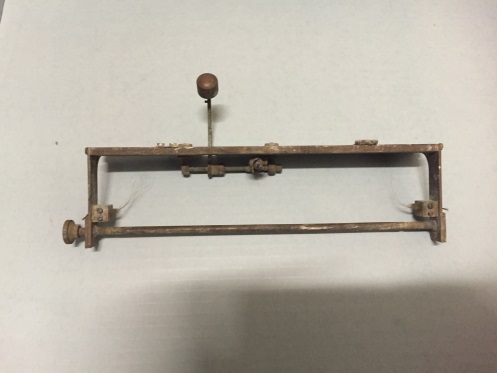 Monitoring the weather was one of many tasks assigned to a lighthouse keeper. They would use a tool called a hygrometer, which we highlighted in a previous blog, to take humidity readings. Horsehair was strung across, which would react to the change in humidity causing the needle to move indicating the relative humidity of the area. Here are the inner workings for a 19th century Hygrometer. It was found during an archaeological excavation of the keepers’ trash pit while building our visitor center. We have found many objects that the keepers had discarded that we have used to help us better understand their lives.
Monitoring the weather was one of many tasks assigned to a lighthouse keeper. They would use a tool called a hygrometer, which we highlighted in a previous blog, to take humidity readings. Horsehair was strung across, which would react to the change in humidity causing the needle to move indicating the relative humidity of the area. Here are the inner workings for a 19th century Hygrometer. It was found during an archaeological excavation of the keepers’ trash pit while building our visitor center. We have found many objects that the keepers had discarded that we have used to help us better understand their lives.
Ladle
In 1869 construction started on a suspension bridge over the East River connecting Brooklyn and Manhattan. This bridge took 14 years and over 600 workers to complete it. During construction this iron ladles, such as this one, were used to pour lead in to molds. This ladle was donated to us in 1993 by the grandson of one of the men who helped to construct the bridge.
Trash Can
This standard issue Army, metal wastebasket was used during WWII in a Women’s Auxiliary Army Corps, or WAAC, office. Over 150,000 women served as officers or enlisted personnel during the war. The idea of WAAC was presented to congress by Congresswoman Edith Nourse Rogers to train women as communication specialists and dietitians. This was donated to us in 2007 by a former WAAC who was stationed on the Pensacola Naval Air Station during the war.
Turkey Call
Keeper David Swain and a friend of his, Mr. Spreights, would hunt for ducks and turkeys here on Anastasia Island. Swain and Spreights made this turkey call in the mid-20th Century. The wood object is composed of two main parts; the larger portion is shaped into a very general block that could fit in a hand. There is also a smaller top piece of wood carved to match the dimensions of the block of wood and is attached with a screw which allows the top to swivel. This top is also has curved surface.
Additionally, the interior of the block has been hollowed out. How this works as a turkey call is the top portion (with the small handle) is moved side to side rubbing the larger block. Because the box has been hollowed out, the sides or edges of the large piece are very thin and with fiction (caused by the top moving) that energy causes vibrations in the wood, which are then amplified by the hollowed out portion of the wood block. The end result is a high pitch squeaky sound that in the hands of the right person can replicate the sounds turkeys make.
The movement and sound created requires a little bit of touch and finesse to make a sound similar to turkeys, but is very achievable and fairly accurate. The indirect evidence of the successful use of this turkey call can be seen in our historic images from the site. One particular photography has an image of Keeper Swain holding two turkeys from a successfully hunt in front of one of the buildings at the Lighthouse. (check out https://www.instagram.com/stauglighthouse/)
Lens Room Brush
When we hear the word “brush” at the Lighthouse our first thoughts are probably about painting, however, before the lighthouse was electrified, keepers were required every morning to clean numerous areas in the tower and lens room. The burning of oil/kerosene at night would create soot and collect on the lens. For this type of work they were equipped with a serious of standard issued cleaning implements and brushes. They used feather dusters for the lens cleaning, and had multiple soft camel hair brushes for polishing, cleaning frame work and even cleaning the stairs.
This particular brush is long handled (well over 12 inches) and could have been utilized for lens framework, walls and hard to reach places in the lens room. Lens brushes had to be soft enough not to scratch any of the prisms.
Catcher’s Mitt
During training the US Coast Guard baseball team practiced in present day Francis Field. This mitt was given to a young boy by the catchers after the equipment had worn out. This particular mitt is in good shape. Typically catcher’s mitts are worn completely out since they are a specialized glove that receives constant heavy impact.
Baseball gloves or mitts became common by the end of the 1800s. One of the early patents on a catcher’s mitt is dated from 1890. The early forms were primarily a padding to cover the hand, and sometimes were fingerless. However, a shift in design by adding a web portion between the thumb and index finger changed the perspective of a padded glove for protection into a glove that also served as a tool or game changer.
By the 1940s, baseball was extremely popular in the United States, and as soldiers headed overseas during World War II so did baseball gloves.
Sailors’ Fid
Sailors’ fids were an important tool for a sailor to have on board the ship. They are commonly used to splice two pieces of rope together to strengthen it or to form a knot. The small end of the fid is inserted into the rope and worked through to make a hole big enough to string a second piece of rope through. They also came in handy when dealing with tough knots, and working with sail as well. They are typically made out of dense wood such as hickory, ash and lignum vitae. This particular fid is about 14 inches long.
If you would like to participate in our next Fact or Fiction Night, visit our website to find out how you can become a St. Augustine Lighthouse & Maritime Museum member!
Jason Titcomb is the Chief Curator for the St Augustine Lighthouse & Maritime Museum. He holds a graduate degree in anthropology from Iowa State University.
Barb Holland joined the Lighthouse family in 2012 and currently works as the Collections Manager. She has a bachelor’s degree in history from Aquinas College in Grand Rapids, Michigan.


